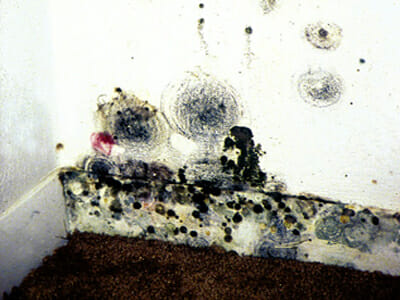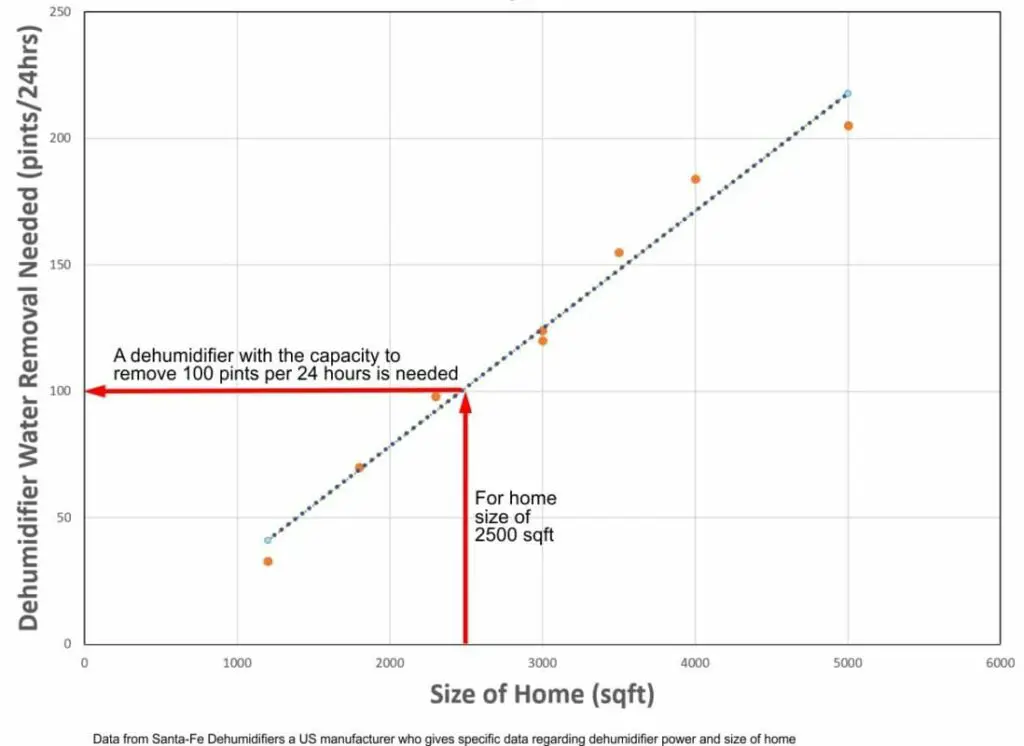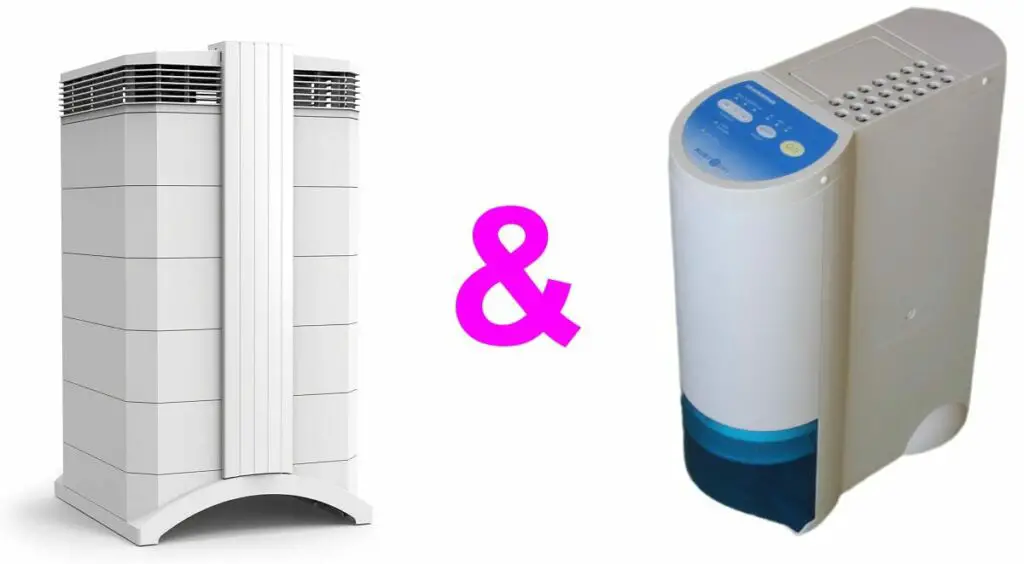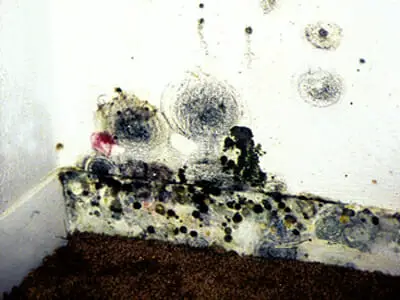The one thing that we all want at home is to feel comfortable. Not only does air in the humidity range of 30-50% feel more comfortable, but it is better for your house and furniture as wood has an optimal humidity range as it absorbs and releases moisture. Also, keeping humidity in an ideal range is also better for your health as house dust-mite proliferate if the indoor humidity is above 50% and mold can grow above 60%.
As a general rule a whole house dehumidifier will give you more widespread and likely cheaper dehumidification than stand-alone units. Also, your home will not be littered with appliances.
I have written a thorough review and drawn diagrams of systems, which I hope you will find helpful. There is also a new way of installing a whole house dehumidifier, which may mean that you wish to get an HVAC engineer to alter the duct work on your current one.
So let’s investigate why you should and how you can improve your home’s humidity.
What are the Benefits of a Dehumidifier
- Feeling more comfortable-high humidity impairs our ability to reduce our temperature by evaporation of sweat from our skin
- Prevent fungal (mold) growth
- Stop house dust mite proliferating and so decrease allergic reactions to those allergic to house dust mite. Approximately 60% of asthma due to house dust might allergy is caused by high indoor humidity.
- Asthmatics find breathing easier when the humidity is within the normal range
Do I Need a Whole House Dehumidifier?
There are 3 ways of ascertaining whether you need a dehumidifier.
Signs of Excess Humidity
The first is relatively crude and involves looking for signs excess water in your home from high humidity-
- Water condensing on the inside of windows
- Water stains that cannot be explained by leaks eg in the roof, leaks from plumbing
- Growth of mold on walls or ceilings-usually black as seen in this illustration (Copyright EPA)-

Sensing High Humidity
We do not have any humidity sensors in our skin and so use mechanical and temperature sensors in our skin to sense humidity. The higher the humidity the more hydrated our skin is and so when we move or touch objects depending on the hydration of the skin, the signals from the mechanical sensors will be slightly different.
Also the higher the humidity, the more water will be in and on our skin and then evaporating from the skin so cooling it. This cooling sensation would of course be more noticeable at colder rather than hotter temperatures. It could also be confused by the amount that we are sweating at higher temperatures.
By the time we are noticing a musty smell mold is probably growing in the home so it is rather late to be discovering a problem.
So relying on our senses is not likely to be the best way to go
Direct Measurement of Humidity
This is more precise, you would use a hygrometer to measure humidity at various times of the year. Hygrometers are quite cheap starting at less than $20 and this method would let you know when your home’s humidity level is high and precisely how high it is.
There are some areas of the US that will probably not need dehumidifiers-
- 1) Desert areas
- 2) Northern plains-most
- 3) Great lakes
- 4) New England
I would recommend getting a humidity meter and doing some measurements of humidity first before buying a central dehumidifier. You really only need one if your indoor humidity exceeds 50% at some times of the year.
Where Does the Humidity Come from?
Usually approximately 50% of the moist air comes from the crawl space or basement. Some moist air comes from the outside through the envelope of the building, eg cracks around entry sites for pipes, when the front door is open, windows that do not fit perfectly. About 25 pints per day of water will be put into the air by a family living in a home. For instance, cooking will release water into the air, also there is water vapour in our breath when we breathe out and evaporation from our skin, showers and baths will also increase the indoor humidity level.
There is a “stack effect” with warm dry air rising in the home and leaving through the top of the home to be replaced by moist air from the crawl space or basement.
Won’t My Air Conditioning Unit Reduce the Humidity?
Air conditioning units do remove water from the air. This is because the air conditioning coils in your HVAC system become very cold and water condenses out of the air as the coils cool it. The problem is that when you are HVAC system is off, this is not occurring. If you have an AC system which is really too large for your home, then it will quickly bring the temperature down to your set temperature and switch off. So the AC system spends so much of the time off it does not effectively reduce the humidity.
Another problem with using the AC system to reduce humidity is that you will not want system on at times in the spring air and water when the humidity is high but the temperature is fairly low.
Advantages of a Whole House Dehumidifier
- 1. Much less maintenance
- 2. Fewer ugly appliances littering the home
- 3. About the same cost in the long run depending on how many portable units you would need
- 4. More comprehensive dehumidification throughout the home
I may be lazy, but I will really like to cut down on unnecessary maintenance. Dehumidifiers are almost as bad as humidifiers for needing maintenance. Unless they are plumbed in with the drain hose going into a drain, they will still need the water collection bucket emptying every day; or every other day if the humidity is not too high.
The water bucket will then need cleaning and drying before being put back into the dehumidifier. Although this is a pain in the neck to do for one dehumidifier if you have 3 or 4 of them in your house it is going to make life difficult. So having a whole house dehumidifier that just gets on with the job without you having to intervene is a very attractive proposition.
I also kind of like the way my house looks, and I do not want white boxes everywhere. If you were going to condition your air perfectly, you would have a humidifier, dehumidifier and air purifier in each room. So each room would have 3 white appliances. Not exactly the pinnacle of interior design! So incorporating these 3 functions into your HVAC system also makes sense from the point of home design.
You may wish to read these articles on whole home air purification and whole home air humidification.
The cost for buying separate dehumidifiers for your main rooms is going to add up and may not be all that far off simply installing a dehumidifier in your existing HVAC system if you have one.
Types of Whole House Dehumidifier
1) Large Capacity Standalone Dehumidifiers For a Whole House
Standalone dehumidifiers range from covering an area of 650 to 5000 ft.². However, I have seen adverts for 50 pint water removal over 24 hour dehumidifier, one claiming to service an area 650 ft.² and the other claiming to serve as an area of 4500 ft.²! So I am skeptical about some claims. Even more so when a reputable manufacturer of whole house HVAC dehumidifiers Ultra-Aire specify their 98H unit as removing 98 pints of water per day and specify it as being suitable for homes up to 2300 sq-ft (please see video below). So, using Ultra-Air data I have plotted a graph below which shows that most homes would need around 100 pints per day of water removing capacity.
Consumer Reports large dehumidifiers recommended only go up to a capacity of 50 pints per day. For some flats or small townhouses there are not HVAC system is available to insert an HVAC dehumidifier into. Fortunately, there are some very large capacity commercial dehumidifiers that will remove up to 50 pints per day. An example is the Colzer 140 Pints Dehumidifier. Ideally you would plumb the outlet of this into a drain so you do not have to keep constantly emptying water from the bucket in the dehumidifier.
Even if it could technically service the area, if the outlet from a portable dehumidifier is only in the room where the dehumidifier is. Very little dehumidifier air may reach rooms that are distant from the dehumidifier. So the dehumidifier air would have to diffuse into the other rooms. With an HVAC whole home dehumidifier there is ducting supplying each room with dehumidifiers air. So the distribution of air from a whole home dehumidifier is better than a large portable dehumidifier.
One way of getting around the problem of having portable dehumidifiers in the way in a flat is to have an on the wall dehumidifier such as the IW25-4 IN Wall/ ON Wall dehumidifier. This needs to drain into the plumbing and is rated for a flat of 1500 sq/ft although this may be optimistic as it removes only 29.5 pints per day. It is relatively quiet at 45db.
If you do decide to have portable dehumidifiers, you could start with one on each floor of your home and test the humidity with a meter and then increase the number of units until you have control of the units.
2)Dehumidifier integrated into HVAC system
There are many established good dehumidifiers for integrating into an HVAC system. These can be integrated in either of 2 ways-
- 1) In series with the existing system integrated into the return duct. So air from the return duct flows into the dehumidifier, a “return to return” configuration.
- 2) As a separate system which has its own return duct and then the outlet from the dehumidifier goes into the supply ducts. This is more recent development and has some advantages –
“Return to Return” Configuration
This is shown in the diagram below –

So the air enters the dehumidifier from the return duct and is blown through the dehumidifier into the return duct. This has several disadvantages –
1) there is some resistance to airflow from the air going through the air handling unit where the heating, cooling coils and fan for your HVAC system are located. If the HVAC fan is off, this will provide some resistance and slow the airflow through the dehumidifier so that less air is dehumidified.
2) if the HVAC/AC fan turns on when the dehumidifier turns on then if this happens soon after the air conditioning has turned off there will still be condensed water on the cooling coils and water vapor will be blown into the home. This will reduce the effectiveness of dehumidification until all the water has evaporated from the cooling coils.
3) if the HVAC fan was turns on when the dehumidifier comes on you will be paying for electricity both for the fan and the dehumidifier
4) the warmer dehumidify air will tend to warm the cooling coils in the air conditioning unit forcing it to work harder to lower the temperature of the air and also preventing at removing some moisture from the air
5) the system will not achieve as low humidity as a dehumidifier with a dedicated return duct sending dry air to the supply duct. In use this configuration may lead to a relative humidity as much as 7% higher than the newer configuration outlined below.
Independent Return Duct to Supply Duct Configuration
Over the last few years there has been a switch to a different configuration in which the dehumidifier has its own return duct and links into the supply duct to the rooms. This means that it can run independently of the HVAC air handling unit. Not even the fan needs to be on.
Thie diagram below shows this arrangement, which is now arguably the preferred configuration for a whole home dehumidifier.

The only problem is that the air from the HVAC system will be slightly warmer as the warmer air from the dehumidifier has not gone through the AC cooling coils. However because the air is drier, it will probably still feel comfortable as dryer air feels more comfortable. Anyway if the temperature rises in your home, the air conditioning system will reduce it to target again.
Option for Increased Fresh Air Ventilation
With this configuration you can even have a duct from the outside feeding into the intake duct to the dehumidifier. Then fresh air will enter your home and have the water vapor removed by the dehumidifier before entering the supply ducts. In this way you get continuous ventilation with the water vapor taken out of the air entering your home.
Other Useful Features You Should Look for in Choosing a Whole Home Dehumidifier
You should consider getting one with-
- 1) Built in humidistat-so that you can adjust the humidity level. You may feel best with a relative humidity of 40-50% in the summer and 30-40% in the winter.
- 2) Auto Restart-if the power to the dehumidifier cuts out, then when it comes back on the system should start itself up.
Will a Whole Home Dehumidifier Be Enough to Really Dehumidify My Whole Home?
Provided you buy an adequately powered dehumidifier, then it should be enough to do dehumidify your whole home. Below is a graph so you can look up the size of your home and estimate the size of dehumidify that you will need –

Every home will have different characteristics, some little more airtight than others, and may need smaller dehumidifiers as less humid air will be leaking into the building. Therefore, you will need to crosscheck with an HVAC specialist who has actually visited your home that this will give you a rough ballpark figure.
The amount of moisture removal needed is mainly dependent on home size, but the number of rooms also has an impact. These figures assume a 2 bedroom home if you have 5 bedrooms you will need to add 25% extra water removal capacity or refer to the table on page 11 of this document.
If your home is not very air tight you will need more capacity than if it is air tight as moist air will be leaking in at a greater rate.
Some of the most powerful domestic central dehumidifiers go up a water removal capacity of 120 pints per 24 hours. However, there is nothing to stop you putting in parallel units side by side to double, triple…. the effectiveness of the system.
So yes, a whole home dehumidifier really will be powerful enough in some configuration to remove excessive humidity from your home. You will need to consult an HVAC engineer to find the best configuration for your house.
What Does a Whole House Dehumidifier Cost?
A whole house dehumidifier will probably cost $1800 for both the unit and parts. Duct work and dehumidifier installation will probably cost $300-600. This would be for a home of 2300 sq-ft. It does of course depend on the size of the house and location and setup of the HVAC unit.
An example of a unit can be seen here-
A whole house dehumidifier will consume 600-1500 watts when on. For instance, the Santa-Fe Ultra-air 98H removes 98 pints per day and is suitable for a home of 2300 sq-ft uses 670 watts at 60% humidity and 80 degrees F. At higher humidity levels it will use more power.
A large portable dehumidifier will consume considerable power when operation, an example is the GE ADEW45LY consumes 860watts and removes 50 pints per day.
So a central dehumidifier is significantly more efficient and will cost about $10/month to run whereas a portable unit may cost $25/month. So just in electricity costs you are likely to save $100 or more per year from a central dehumidifier just in electricity costs. Obviously if you have 2 portable dehumidifiers to reach more areas of your house, the savings double and so on.
As central units last longer than portable units, you will also save on replacement costs.
For any dehumidifier, the percentage of the time that the dehumidifier is on depends on how much humidity there is in the home. So sealing your home and reducing the amount of humid air leaking in will reduce the amount of time for which the dehumidifier works.
The cost is offset by the fact that the air feels much more comfortable and as you feel more comfortable at higher temperatures and you can run your air conditioner less. So you will consume less electricity on air conditioning.
Are Whole House Dehumidifiers Noisy?
In general whole house dehumidifiers are less noisy for someone in one of the rooms than equivalent capacity portable dehumidifiers.
This may seem strange as they both emit similar levels of noise, but there are 2 reasons for this-
- Distance From the Sound. Sound decreases according to the inverse square law in other words the intensity decreased very quickly with your distance from the sound source. So if you are twice as far from the sound source, experience one quarter of the sound intensity. Thus one advantage of a central dehumidifier is that you will be much further away from the sound source than you would be from portable dehumidifier.
- Barrier Between You and the Sound. In addition, the source of the sound will be in another enclosed space where your HVAC system is so there will be a barrier between you and the sound.
Both of these factors will cut the noise that you hear from a central dehumidifier significantly from that in the table below. The table gives the noise that you would hear if you were next to the dehumidifier.
Table of various aspects of whole house dehumidifiers compared to portable dehumidifiers-
| Model | Water Removal Capacity (pints over 24 hours) | Noise Level | Maximum Area Served (sq ft) | Filter Specification |
|---|---|---|---|---|
| Portable | ||||
| Honeywell TP70WKN | 50 | 51db | “large room” | No rating |
| GE ADEW45LY | 45 | 47db | not specified | No rating |
| Whole House | ||||
| Santa-Fe Ultra-Air 98H | 98 | 47.5db | 2300 | MERV 13* |
| Aprilair-Model 1850 | 94 | 54db | “up to 5200” | MERV 8 |
| Santa-Fe Ultra-Air XT | 205 | 59.7 | 5000 | MERV 13 |
*The higher the MERV rating the more particles the filter removes-please see below.
These are the manufacture’s specifications. Having read the website and manuals I am not clear why Aprilair specify their model 1850 as covering an area of “up to 5200 sq-ft” when Santa-Fe specify their Ultra-Air 98H which removes the same amount of water from the air as covering 2300 sq-ft. Presumably the 2 companies are talking about different climatic conditions.
Is the Filter on a Whole House Dehumidifier Good Enough to Improve My Air Quality?
The straight answer is no, not really. As seen from the table above, even the best filters used are MERV 13 and this is not highly specified enough to improve air quality enough to improve health significantly-please see this article.
The air flow through a whole home dehumidifier is 300-500 cubic feet per minute. This is the equivalent of 2 large air purifiers on their maximum setting.
So this is a lost opportunity for the companies producing these devices-they should team up with iQair and use the iQair Nanomax [need link MERV 16 filter with their dehumidifiers. Or at least provide the consumer with the option.
How Long Does a Whole House Dehumidifier Last?
As a general rule, whole house dehumidifiers last 5-10 years. The warranty on the dehumidifier units themselves are usually in the range of 5-6 years. This is compared to a warranty on a portable dehumidifier of 2 years.
Conclusion
I hope that this review is helpful in choosing a dehumidification system and improving your indoor air quality. If you have an HVAC system but no dehumidifier linked to it you may really benefit from having one. It would be best to measure the humidity in your home at different times of the year and times of day first to make sure that you need one.
As you have seen, if you have one that is set up in a “return to return” configuration, it is likely that you could make it more effective ventilation by reconfiguring the duct work. If you do this by having a dedicated external air vent that enters the dehumidifier duct, you can also improve your home’s ventilation.
Every home will have its own unique properties, and so you should consult an HVAC engineer if you consider having your HVAC system remodelled.
References
EPA Mold Course and Humidity
Santa-Fe specialist dehumidifier manufacturers- ASHRAE table for Dehumidifier capacity adjustment depending on number of bedrooms (Page 11)
CDC Guidelines for indoor air quality https://www.cdc.gov/niosh/topics/indoorenv/temperature.html
American Society of Heating, Refrigerating and Air-Conditioning Engineers ASHRAE-specifications for indoor temperature and humidity
Related Questions
Related Posts
Air Purifier and Dehumidifier Combo



